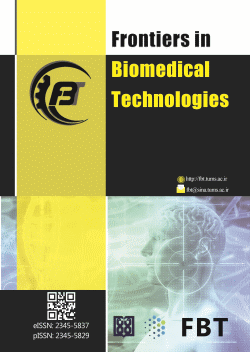The Effect of Various Parameters on Measuring Alpha and Beta Particles from Soil Sample; An Environmental Dosimetry
Abstract
Purpose: The measurement of natural radioactive decay in environmental samples such as soil has received increasing importance in recent years. Proportional counters in the form of large-area planar detectors are widely used for the initial screening of radioactivity in environmental samples. In this study, the affecting factors in the alpha and beta particles emitted from natural radioactive soil sample was simulated using the Monte Carlo FLUKA code.
Materials and Methods: These factors include the thickness of the sample, source-detector air gap, Mylar thickness, and gas detector density. Simulations were performed for alpha particles in 4.8 MeV and in the conventional range for the investigation of radioactive elements inside the soil sample.
Results: The final analyzed results show that the maximum number of primary particles can be measured up to 5 and 100 µm of soil sample thickness for alpha and beta particles, respectively. The maximum counting efficiencies for alpha and beta particles are 23% and 42%, respectively for our simulated sample.
Conclusion: For alpha particles, gas detector density variations have no effect on the efficiency. For beta particles, this efficiency is constant up to 0.0005 g/ density of gas. Furthermore, by increasing the air gap and Mylar thickness the efficiency will be decreased for both alpha and beta particles, while the variation of this value is remarkable for alpha particles.
2. Gorur, F.K. and H. Camgoz, Natural radioactivity in various water samples and radiation dose estimations in Bolu province, Turkey. Chemosphere, 2014. 112: p. 134-140.
3. Jobbágy, V., U. Wätjen, and J. Meresova, Current status of gross alpha/beta activity analysis in water samples: a short overview of methods. Journal of radioanalytical and nuclear chemistry, 2010. 286(2): p. 393-399.
4. Kapdan, E., et al., A study of environmental radioactivity measurements for Cankiri, Turkey. Radiation Protection Dosimetry, 2012. 150(3): p. 398-404.
5. Li, X., et al., Simultaneous determination of gross alpha/beta activities in water by liquid scintillation counting and its applications in the environmental monitoring. Scientific Reports, 2022. 12(1): p. 8281.
6. Timón, A.F., et al., Influence of source composition and particle energy on the determination of gross alpha activity. Applied Radiation and Isotopes, 2013. 82: p. 376-381.
7. Turhan, Ş., et al., Determination of natural radioactivity by gross alpha and beta measurements in ground water samples. Water research, 2013. 47(9): p. 3103-3108.
8. Knoll, G., Radiation Detection and Measurement3rd edition John Wiley and Sons. New York, 2000.
9. L'Annunziata, M.F., Handbook of radioactivity analysis. 2012: Academic press.
10. Mbonu, C.C. and U.C. Ben, Assessment of radiation hazard indices due to natural radioactivity in soil samples from Orlu, Imo State, Nigeria. Heliyon, 2021. 7(8): p. e07812.
11. Missimer, T.M., et al., Natural radiation in the rocks, soils, and groundwater of Southern Florida with a discussion on potential health impacts. International journal of environmental research and public health, 2019. 16(10): p. 1793.
12. Ogundare, F. and O. Adekoya, Gross alpha and beta radioactivity in surface soil and drinkable water around a steel processing facility. Journal of radiation research and applied sciences, 2015. 8(3): p. 411-417.
13. Abbas, M.I., Direct mathematical method for calculating full-energy peak efficiency and coincidence corrections of HPGe detectors for extended sources. Nuclear Instruments and Methods in Physics Research Section B: Beam Interactions with Materials and Atoms, 2007. 256(1): p. 554-557.
14. Gliniak, M., et al., Using Geiger Dosimetry EKO-C Device to Detect Ionizing Radiation Emissions from Building Materials. Sensors, 2021. 21(2): p. 645.
15. Kalchgruber, R. and G. Wagner, Separate assessment of natural beta and gamma dose-rates with TL from α-Al2O3: C single-crystal chips. Radiation measurements, 2006. 41(2): p. 154-162.
16. Lee, K., J.M. Lee, and T.S. Park, Measurement of beta surface emission rate from an extended area 36Cl source using a multiwire proportional counter. Applied radiation and isotopes, 2005. 63(1): p. 99-105.
17. Abbas, M.I., Y.S. Selim, and M. Bassiouni, HPGe detector photopeak efficiency calculation including self-absorption and coincidence corrections for cylindrical sources using compact analytical expressions. Radiation Physics and Chemistry, 2001. 61(3-6): p. 429-431.
18. Saettel, M., et al., Study of autoabsorption for total α and β counting. Nuclear Instruments and Methods in Physics Research Section A: Accelerators, Spectrometers, Detectors and Associated Equipment, 2008. 590(1-3): p. 151-156.
19. Khan, W., C. He, and Y. Cao, Calculation of self-absorption and coincidence summing correction factors for the extended sources using GEANT4. Radioprotection, 2019. 54(2): p. 133-140.
20. Mas, J., et al., Assessment of natural radioactivity levels and radiation exposure in new building materials in Spain. Radiation Protection Dosimetry, 2021. 194(2-3): p. 178-185.
21. Fasso, A., et al., The physics models of FLUKA: status and recent development. arXiv preprint hep-ph/0306267, 2003.
22. Ferrari, A., et al., FLUKA: A multi-particle transport code (Program version 2005). 2005: Cern.
23. Andersen, V., et al., The FLUKA code for space applications: recent developments. Advances in Space Research, 2004. 34(6): p. 1302-1310.
24. Yalcin, S., et al., Calculation of total counting efficiency of a NaI (Tl) detector by hybrid Monte-Carlo method for point and disk sources. Applied Radiation and Isotopes, 2007. 65(10): p. 1179-1186.
25. Böhlen, T., et al., The FLUKA code: developments and challenges for high energy and medical applications. Nuclear data sheets, 2014. 120: p. 211-214.
26. Guthoff, M., W. de Boer, and S. Müller, Simulation of beam induced lattice defects of diamond detectors using FLUKA. Nuclear Instruments and Methods in Physics Research Section A: Accelerators, Spectrometers, Detectors and Associated Equipment, 2014. 735: p. 223-228.
27. Battistoni, G., et al., The FLUKA code: an accurate simulation tool for particle therapy. Frontiers in oncology, 2016. 6: p. 116.
| Files | ||
| Issue | Vol 12 No 1 (2025) | |
| Section | Original Article(s) | |
| DOI | https://doi.org/10.18502/fbt.v12i1.17739 | |
| Keywords | ||
| Environmental Dosimetry Alpha and Beta Particles Proportional Counters Monte Carlo Simulation | ||
| Rights and permissions | |

|
This work is licensed under a Creative Commons Attribution-NonCommercial 4.0 International License. |




